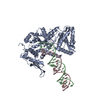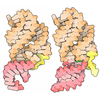+ データを開く
データを開く
- 基本情報
基本情報
| 登録情報 | データベース: PDB / ID: 9mw8 | ||||||
|---|---|---|---|---|---|---|---|
| タイトル | Cryo-EM structure of ancestral Dicer helicase bound to 27-bp dsRNA in post-hydrolysis closed state | ||||||
 要素 要素 |
| ||||||
 キーワード キーワード | ANTIVIRAL PROTEIN/RNA / RNA helicase / dsRBM / ANTIVIRAL PROTEIN-RNA complex | ||||||
| 機能・相同性 | ADENOSINE-5'-DIPHOSPHATE / RNA / RNA (> 10) 機能・相同性情報 機能・相同性情報 | ||||||
| 生物種 | synthetic construct (人工物) | ||||||
| 手法 | 電子顕微鏡法 / 単粒子再構成法 / クライオ電子顕微鏡法 / 解像度: 3.3 Å | ||||||
 データ登録者 データ登録者 | Aderounmu, A.M. / Consalvo, C.D. / Shen, P.S. / Bass, B.L. | ||||||
| 資金援助 |  米国, 1件 米国, 1件
| ||||||
 引用 引用 |  ジャーナル: Proc Natl Acad Sci U S A / 年: 2025 ジャーナル: Proc Natl Acad Sci U S A / 年: 2025タイトル: Biochemical and structural basis of Dicer helicase function unveiled by resurrecting ancient proteins. 著者: Adedeji M Aderounmu / Josephine Maus-Conn / Claudia D Consalvo / Peter S Shen / Brenda L Bass /  要旨: A fully functional Dicer helicase, present in the modern arthropod, uses energy from ATP hydrolysis to power translocation on bound dsRNA, enabling the processive dsRNA cleavage required for ...A fully functional Dicer helicase, present in the modern arthropod, uses energy from ATP hydrolysis to power translocation on bound dsRNA, enabling the processive dsRNA cleavage required for efficient antiviral defense. However, modern Dicer orthologs exhibit divergent helicase functions that affect their ability to contribute to antiviral defense. Moreover, mechanisms that couple ATP hydrolysis to Dicer helicase movement on dsRNA remain enigmatic. We used biochemical and structural analyses of ancestrally reconstructed Dicer helicases to map evolution of dsRNA binding affinity, ATP hydrolysis and translocation. Loss of affinity for dsRNA occurred early in Dicer evolution, coinciding with a decline in translocation activity, despite preservation of ATP hydrolysis activity. Ancestral nematode Dicer also exhibited significant decline in ATP hydrolysis and translocation, but studies of antiviral activities in the modern nematode indicate Dicer retained a role in antiviral defense by recruiting a second helicase. Cryogenic electron microscopy (cryo-EM) analyses of an ancient metazoan Dicer allowed capture of multiple helicase states revealing the mechanism that connects each step of ATP hydrolysis to unidirectional movement along dsRNA. Our study rationalizes the diversity in modern Dicer helicases by connecting ancestral functions to observations in extant enzymes. #1: ジャーナル: bioRxiv / 年: 2025 タイトル: Biochemical and structural basis of Dicer helicase function unveiled by resurrecting ancient proteins. 著者: Adedeji M Aderounmu / Josephine Maus-Conn / Claudia D Consalvo / Peter S Shen / Brenda L Bass /  要旨: A fully functional Dicer helicase, present in the modern arthropod, uses energy generated during ATP hydrolysis to power translocation on bound dsRNA, enabling the processive dsRNA cleavage required ...A fully functional Dicer helicase, present in the modern arthropod, uses energy generated during ATP hydrolysis to power translocation on bound dsRNA, enabling the processive dsRNA cleavage required for efficient antiviral defense. However, modern Dicer orthologs exhibit divergent helicase functions that affect their ability to contribute to antiviral defense, and moreover, mechanisms that couple ATP hydrolysis to Dicer helicase movement on dsRNA remain enigmatic. Here, we used biochemical and structural analyses of ancestrally reconstructed Dicer helicases to map evolution of dsRNA binding affinity, ATP hydrolysis and translocation. We found that loss of affinity for dsRNA occurred early in Dicer evolution, coinciding with a decline in translocation activity, despite preservation of ATP hydrolysis activity, exemplified by the ancient deuterostome Dicer. Ancestral nematode Dicer also exhibited significant decline in ATP hydrolysis and translocation, but studies of antiviral activities in the modern nematode indicate Dicer retained a role in antiviral defense by recruiting a second helicase. Cryo-EM analyses of an ancient metazoan Dicer allowed capture of multiple helicase states revealing the mechanism that connects each step of ATP hydrolysis to unidirectional movement along dsRNA. Overall, our study rationalizes the diversity in modern Dicer helicases by connecting ancestral functions to observations in extant enzymes. | ||||||
| 履歴 |
|
- 構造の表示
構造の表示
| 構造ビューア | 分子:  Molmil Molmil Jmol/JSmol Jmol/JSmol |
|---|
- ダウンロードとリンク
ダウンロードとリンク
- ダウンロード
ダウンロード
| PDBx/mmCIF形式 |  9mw8.cif.gz 9mw8.cif.gz | 155.2 KB | 表示 |  PDBx/mmCIF形式 PDBx/mmCIF形式 |
|---|---|---|---|---|
| PDB形式 |  pdb9mw8.ent.gz pdb9mw8.ent.gz | 表示 |  PDB形式 PDB形式 | |
| PDBx/mmJSON形式 |  9mw8.json.gz 9mw8.json.gz | ツリー表示 |  PDBx/mmJSON形式 PDBx/mmJSON形式 | |
| その他 |  その他のダウンロード その他のダウンロード |
-検証レポート
| 文書・要旨 |  9mw8_validation.pdf.gz 9mw8_validation.pdf.gz | 1.2 MB | 表示 |  wwPDB検証レポート wwPDB検証レポート |
|---|---|---|---|---|
| 文書・詳細版 |  9mw8_full_validation.pdf.gz 9mw8_full_validation.pdf.gz | 1.2 MB | 表示 | |
| XML形式データ |  9mw8_validation.xml.gz 9mw8_validation.xml.gz | 38.7 KB | 表示 | |
| CIF形式データ |  9mw8_validation.cif.gz 9mw8_validation.cif.gz | 57.2 KB | 表示 | |
| アーカイブディレクトリ |  https://data.pdbj.org/pub/pdb/validation_reports/mw/9mw8 https://data.pdbj.org/pub/pdb/validation_reports/mw/9mw8 ftp://data.pdbj.org/pub/pdb/validation_reports/mw/9mw8 ftp://data.pdbj.org/pub/pdb/validation_reports/mw/9mw8 | HTTPS FTP |
-関連構造データ
| 関連構造データ |  48697MC  9mw6C  9mw7C  9mx3C  9mx5C C: 同じ文献を引用 ( M: このデータのモデリングに利用したマップデータ |
|---|---|
| 類似構造データ | 類似検索 - 機能・相同性  F&H 検索 F&H 検索 |
- リンク
リンク
- 集合体
集合体
| 登録構造単位 | 
|
|---|---|
| 1 |
|
- 要素
要素
| #1: タンパク質 | 分子量: 75480.609 Da / 分子数: 1 / 由来タイプ: 組換発現 / 由来: (組換発現) synthetic construct (人工物) 発現宿主:  |
|---|---|
| #2: RNA鎖 | 分子量: 8572.096 Da / 分子数: 1 / 由来タイプ: 組換発現 / 由来: (組換発現) synthetic construct (人工物) / 発現宿主: synthetic construct (人工物) |
| #3: RNA鎖 | 分子量: 8658.198 Da / 分子数: 1 / 由来タイプ: 組換発現 / 由来: (組換発現) synthetic construct (人工物) / 発現宿主: synthetic construct (人工物) |
| #4: 化合物 | ChemComp-MG / |
| #5: 化合物 | ChemComp-ADP / |
| 研究の焦点であるリガンドがあるか | Y |
| Has protein modification | N |
-実験情報
-実験
| 実験 | 手法: 電子顕微鏡法 |
|---|---|
| EM実験 | 試料の集合状態: PARTICLE / 3次元再構成法: 単粒子再構成法 |
- 試料調製
試料調製
| 構成要素 | 名称: Ancestral metazoan Dicer helicase in complex 27-bp blunt dsRNA and ATP タイプ: COMPLEX / Entity ID: #1-#3 / 由来: MULTIPLE SOURCES |
|---|---|
| 分子量 | 値: 0.093 MDa / 実験値: NO |
| 由来(天然) | 生物種: synthetic construct (人工物) |
| 由来(組換発現) | 生物種:  |
| 緩衝液 | pH: 8 |
| 試料 | 包埋: NO / シャドウイング: NO / 染色: NO / 凍結: YES |
| 試料支持 | グリッドの材料: COPPER / グリッドのサイズ: 300 divisions/in. / グリッドのタイプ: Quantifoil R1.2/1.3 |
| 急速凍結 | 装置: FEI VITROBOT MARK III / 凍結剤: ETHANE |
- 電子顕微鏡撮影
電子顕微鏡撮影
| 実験機器 |  モデル: Titan Krios / 画像提供: FEI Company |
|---|---|
| 顕微鏡 | モデル: TFS KRIOS |
| 電子銃 | 電子線源:  FIELD EMISSION GUN / 加速電圧: 300 kV / 照射モード: FLOOD BEAM FIELD EMISSION GUN / 加速電圧: 300 kV / 照射モード: FLOOD BEAM |
| 電子レンズ | モード: BRIGHT FIELD / 倍率(公称値): 105000 X / 最大 デフォーカス(公称値): 2500 nm / 最小 デフォーカス(公称値): 800 nm |
| 試料ホルダ | 凍結剤: NITROGEN 試料ホルダーモデル: FEI TITAN KRIOS AUTOGRID HOLDER |
| 撮影 | 電子線照射量: 40 e/Å2 フィルム・検出器のモデル: GATAN K3 BIOQUANTUM (6k x 4k) |
- 解析
解析
| EMソフトウェア |
| ||||||||||||||||||||||||||||||||||||||||
|---|---|---|---|---|---|---|---|---|---|---|---|---|---|---|---|---|---|---|---|---|---|---|---|---|---|---|---|---|---|---|---|---|---|---|---|---|---|---|---|---|---|
| CTF補正 | タイプ: PHASE FLIPPING AND AMPLITUDE CORRECTION | ||||||||||||||||||||||||||||||||||||||||
| 対称性 | 点対称性: C1 (非対称) | ||||||||||||||||||||||||||||||||||||||||
| 3次元再構成 | 解像度: 3.3 Å / 解像度の算出法: FSC 0.143 CUT-OFF / 粒子像の数: 315941 / 対称性のタイプ: POINT | ||||||||||||||||||||||||||||||||||||||||
| 原子モデル構築 | プロトコル: FLEXIBLE FIT / 空間: REAL | ||||||||||||||||||||||||||||||||||||||||
| 原子モデル構築 | Source name: AlphaFold / タイプ: in silico model | ||||||||||||||||||||||||||||||||||||||||
| 拘束条件 |
|
 ムービー
ムービー コントローラー
コントローラー







 PDBj
PDBj

































